[FONT=Arial, Helvetica, sans-serif]The Udasis[/FONT][FONT=Arial, Helvetica, sans-serif] by Hugh Mcleod [/FONT]
[FONT=Arial, Helvetica, sans-serif]The Earliest of these sects is unquestionably that of the Udasis, though its importance is historic rather than contemporary. Modern sikhism is generally opposed to asceticism and for that reason alone it has little place for the Udasis. This was not always the case. Prior to the period of the Singh Sabha movement (the late nineteenth and twentieth centuries), the Udasi way enjoyed considerable prestige, and under the Sikh rulers of the Punjab its practitioners were recipients of substantial land grants. The eclipse of asceticism in general and of the Udasis in particular reflects the convictions of the Tat Khalsa.[/FONT][FONT=Arial, Helvetica, sans-serif]Today one finds few Udasi centres, the yogis of the Udasi way being banished to the outer fringes of the Sikh Panth. Many Sikhs refuse to accept them as their co-religionists. [/FONT]
[FONT=Arial, Helvetica, sans-serif]The Udasis were an ascetic group, claiming descent from Siri Chand (one of Guru Nanak's two sons) and following the path of renunciation (udas). Their austerities, their celibacy and their refusal to acknowledge such practices as keeping their hair uncut made them very different from the Khalsa, but they nevertheless maintained they were Sikhs. Although they recognized the line of ten Gurus from Nanak to Gobind Singh the Udasis were much more interested in the chain of succession, which descended from Siri Chand down to the reigning Mahant (Superior)of the branch they followed. They revered the Adi Granth, imparting to its teachings a distinctly Hindu twist. Like other Sikhs they wrote commentaries on particular portions of the Sikh scripture, together with janam-sakhis and gur-bilas works. [/FONT]
[FONT=Arial, Helvetica, sans-serif]Never uniform in terms of organization or doctrine, the Udasis numbered more than a dozen orders by the end of Sikh rule in 1849. By this tirne they had more than 250 akharas or centres. They were respected by the early Panth, particularly as Gurditta (the eldest son of Guru Hargobind) evidently favoured them. During the eighteenth century they were not targeted by the rulers, as were the orthodox Khalsa, with the result that many gurdwaras evldently passed into their care. Certainly the mahants of the late nineteenth century frequently claimed an Udasi descent, though their lifestyle was by this time very different from that of the traditional Udasis.[/FONT]
[FONT=Arial, Helvetica, sans-serif] Khalsa Sikhs, as we have seen, became increasingly uneasy about Udasi authority over gurdwaras, and during the Gurdwara Reform Movement of the early 1920s all the so-called Udasis were summarily ejected from positions of control.' The turning-point of the campaign came in 1921 when the Mahant of Nankana Sahib (who had declared himself to be an Udasi) caused the massacre of a large group of Akalis, an event that branded all Udasis as the enemies of the true Khalsa. During Singh Sabha days they had been targeted by the Tat Khalsa as prime examples of Hindu influence and are now but the palest shadow of their earlier wealth and power. [/FONT]
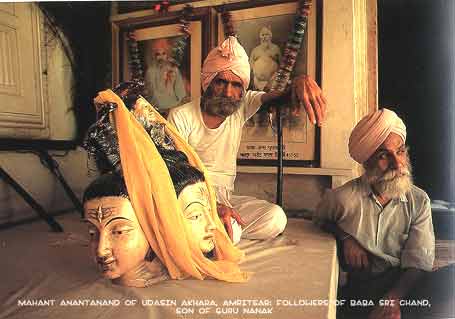
[FONT=Arial, Helvetica, sans-serif]Mahant Anantanad Maharaj of the Udasin Akhara, Amritsar. (Photo courtesy Raghu Rai - "The Sikhs")[/FONT]
[FONT=Arial, Helvetica, sans-serif]The following detailed account of the Udasis has been taken from the book by H.A.Rose - "A Glossary of the Tribes and Castes of the Punjab and the North-West Frontier Province." written around 1892 AD[/FONT]
[FONT=Arial, Helvetica, sans-serif]Udasi.-Syn. Nanak-putra: the principal religions order of the Sikhs. The Udasis are almost certainly the oldest of the Sikh orders, and trace their foundation to Sri Chand,1 the elder son cf Guru Nanak. 'The term 'Udasi' means a sorrow' or sadness, from Sanskrit Udas, 'sad' and their separation, which has sometimes been wrongly termed excommunication, by the 3rd Guru', Amar Das, is described in Vol.1 under Sikhism. 'this separation is sometimes ascribed to Guru' Arjan.[/FONT]
[FONT=Arial, Helvetica, sans-serif]The Udasi tenets, though largely tinctured with Hindu asceticism, found many proselytes among the descendants and followers of the orthodox Guru's, and Har Gobind,the 6th Guru, bestowed Gurditta,2 his eldest son on Sri Chand. Gurditta had four disciples who founded as many chapters (dhuan) of the order. These were Baba3 Hasan, PhuI4, Gonda5 and Almast 6, whose followers constitute the bara akhara, or senior assembly. Pheru, a disciple of Har Rai, the 7th Guru', established another chapter, called the chhota akhara 7[/FONT]
[FONT=Arial, Helvetica, sans-serif]The Uddasis are celibate, at least in theory, and when so in practice are called Udasi Nanga or' naked.' But Maclagan gives a different explanation of this term as will - be seen from the following extract from his account of the order -" The Udasi's are recruited from all castes and will eat food from any Hindu. They are almost always celibates, and are sometimes,though not usually, congregated in monasteries. They are generally found wandering to and from their sacred p laces, such as Amritsar, Dera Nanak, Kartarpur, and the like. They are said to be numerous in Malwa and in Benares. In our Census returns they appear strongest in Jullundur, Rohtak, and Ferozepnr. It is a mistake to say that they are not generally recognised. as Sikhs ; they pay special reverence to the Adi-granth, but also respect the Granth of Gobind Singh, and attend the same shrines as the Sikhs generally. Their service consists of a ringing of bells and blare of instruments and chanting of hymns and waving of lights before the Adi granth and the picture of Baba Nanak. They are, however, by no means uniform in their customs. Some wear long hair, some wear matted locks, and others cut their hair. Some wear tilaks or caste-marks; others do not. Some burn the dead in the ordinary Hindu way; some after burning erect samadhs or monuments; other, apparently bury the dead. They are for the most part ascetics, but some are said to be engaged in ordinary secular pursuits. The ordinary dress of the ascetics is of a red colour, but a large section of them go entirely naked, except for the waistcloth, and rub ashes over their bodies. These, like the naked sections of other orders1 are known as Nange; they pay special reverence to the ashes with which they smear their bodies, and which are said to protect them equally from either extreme of temperature. Their most binding oath is on a ball of ashes.[/FONT]
[FONT=Arial, Helvetica, sans-serif]In Ludhiana the Udasis are described as mostly Jats by origin, the chela or disciple and successor, being usually chosen from this tribe and are found to be in possession of the dharamsalas in Hindu villages, where they distribute food to such as come for it and read the granth both of Baba Nanak and of Guru Gobind Singh although they do not attach much importance to the latter. The head of the college is called a mahant and the disciples chelas. They live in Sikh as well as in Hindu villages, and it is probably on this account that they do not quite neglect Guru Gobind Singh. They rarely marry; and if they do so, generally lose all influence, for the dharmsala soon becomes a private residence closed to strangers. But in some few families, such as that. of Jaspal Bangar, which keeps a large langar or almshouse going, it has always been the custom to marry, the endowments being large enough to support the family and maintain the institutions; but the eldest son does not in this case succeed as a matter of course. A chela is chosen by the Mahant, or by the family. If a mahant whose predecessors have not married should do so, he would lose all his weight with the people.[/FONT]
[FONT=Arial, Helvetica, sans-serif]The great shrine at Dera Baba Nanak, in the Gurdaspur district is in the custody of a community of Udasi Sadhs, whose mahant used to be appointed with the consent of the Bedis Another shrine at the same place, known as Tahli Sahib, froom a large Tahli or Shisham tree, which grew close to it, was founded by Sri Chand, and is also looked after by mahants of the Udasi order."[/FONT]
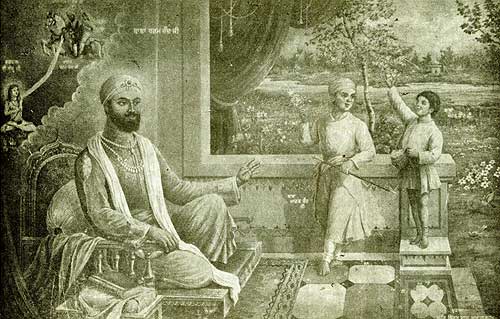
Baba Dharam Chand Ji with his 2 sons Baba Manak Chand and Baba Mehar Chand
[FONT=Arial, Helvetica, sans-serif]Another chapter of the Udasi order, said sometimes to be one of the four dhua'n, is called the Bhagat Bhagwan. Once Bhagatgir, a Sanni-asi going on a pilgrimage to Hinglaj, with a band of disciplea, and visited Baba Nanak's dera on his way. Nanak's grandson, Dharm Chand, poured food into the howl of Bhagatgir, who had asked to be served first, but it was not filled. A pinch of karah prasad, however, given with the words, 'Sri Waheguru', filled the bowl at once. The visitors kept a vigil before the dera and the goddess Hinglaj appeared to them, so that the object of their pilgrimage was attained. Bhagatgir then became Dharm Chand's convert, as did all his followers, under the name of Bhagat Bhagwan. The great akhara of the sect is by the Bibiksar tank at Amritsar, but it also has akharas at Ladda, Bareily, Magla, Rajgiri, Patna and Bihar, with 870 gaddis in Eastern India. The Bhagat Bhagwans wear the Jatta or matted hair, with a chain round the waist, and smear themselves with ashes like Sanniassis. In their belief, and in their rules as to eating and the like they follow Nanak's precepts.
The Sangat Sahib also appears to be a chapter of the Udasi order, though it is not one of the four dhuans. In Sambat 1697 a son was born to Binna, an Uppal Khatri of Ambmari in the pargana of Miske Naur,* between Lahore and Multan. The boy was named Pheru, and in 1713 he became cook to Guru' Har Rai, who taught him and invested him with the seli and topi and sent him as a masand to the Lamma (his native country - simply means WEST) and the Nakka (towards Shahpur) where he made converts. When Guru Govind Singh destroyed the masands, by pouring hot oil on their heads, Sikhs were sent to seize Pheru, but non-dared do so, though he made no resistance. Seizing his own beard Pheru came of his own accord to the Guru' who, seeing his righteousness, gave him half his pagri and seated him by himself, promising that his sect should prosper. The Guru also gave him the title of Sangat Sahib or 'companion of the Guru and sent him back as mesand to the Lamma and Nakka where he made more converts. In 1896: the Sangat Sahib made a travelling akhara like the Udasis. One of their most noted disciples. Santokh Das, worked many miracles, and became an ascetic. This order is also said to be called Bakhahish Sangat Sahib in Patiala, where it is said to pay special reverence to the Adi Granth and to have an akhara of its own, separate from the four dhuans. Other accounts say that the Sangat Sahibia sub-order was founded by one Bhai Bhalu who was a Jat 'merchant' of the Malwa or a carpenter of Amritsar. When unregenerate he was a follower of Sultan Sakhi Sarwar, but was persuaded by Guru Govind Singh to abandon that cult. A large number of Jats, carpenters and Lohars are said to belong to this suborder. Besides a Gurdwara in Lahore it holds the Brahmbhut akhara at Amritsar.[/FONT]
[FONT=Arial, Helvetica, sans-serif]Another Udasi suborder is that of the Ramdas Udasis. Its founda-tion is ascribed to Gurditta (not the eldest son of Guru Hargobind but a grandson of Baba Bandha, one of Baba Nanak's converts ?). Gurditta was established by Guru Amardeo (?Amardas) on a gaddi at Ramdas, in the Ajnala tehsil of Amritsar, where there is a fine temple. The suborder also has deras at Nawekot, Muradabad and elsewhere.[/FONT]
[FONT=Arial, Helvetica, sans-serif]The Hiradasis of our Censas returns appear to be either named after a Mochi who joined the order or after a Bairagi saint of the Muzaffar-garh district.[/FONT]
[FONT=Arial, Helvetica, sans-serif]Each subdivision of the Udasis has a complete organisation for collect-ing and spending money, and is presided over by a principal mahant called Sri Mahant, with subordinate mahants under him.[/FONT]
[FONT=Arial, Helvetica, sans-serif]1. Malcolm says Dharm Chand, clearly an error.
2. On a hill near Rawalpindi lived Budhan Shah, a Muhammadan faqir, to whom Baba Nanak had entrusted some milk till his successor should come to claim it. Seeing Gurditta approaching Budhan Shah begged him to assume Nanak's form. This Gurditta did and thereby earned the title and dignity of Baba: Maclagan, . He lived mainly at Kartarpur but died at Kiratpur where he has a handsome shrine. From another shrine there, called the Manji Sahib he is said to have shot an arrow which fell in the plain below at a place called Patalpuri., long used as a burning ground for the Sodhi Khatris.
3. Baba Hasna's shrine is at Charankaul, near Anandpur.
4. Phul Sahib's shrines are at Bahdurpur and Chinighat in Hoshiarpur.
5. Gonda Sahib is represented at Shikarpur in Sind and at the Sangalwala Gurdwara in Amritsar.
6, Almast Sahib is represented at Jagannath and Naini Tal: Maclagan, § 90.
7. This appears to be the Sangat Sahib.[/FONT]
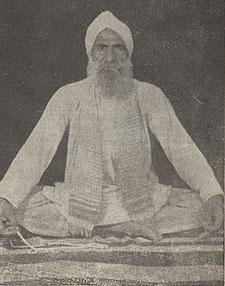
Sri 108 Mahant Bhagat Ram of dera Dharam Das Ji Maharaj - village Bara Pind, Jalandhar. He installed this sculptor of Baba Siri Chand (BELOW)in 1921. This sculptor is over 112 years old.
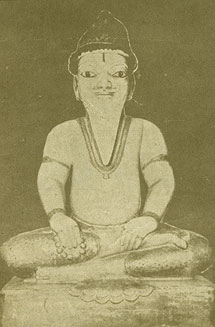
Baba Sri Chand
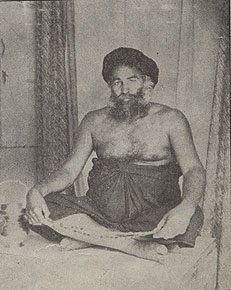
Sri 108 Mahant Baba Ghanshyam Das Ji
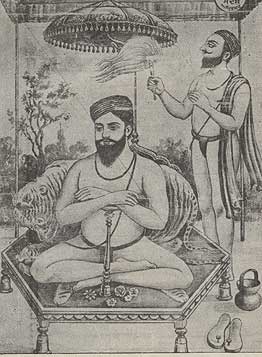
Sri 1008 Nirban Pritam Das Ji Maharaj of Akhara Sangal Wala, Amritsar
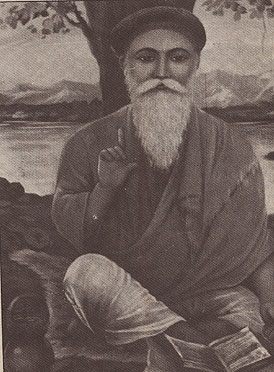
Mahan Kavi Sant Rein who wrote 'Guru Nanak Vijay Granth', the 3rd edition has been printed by Bhasha Vibhag, Punjab.
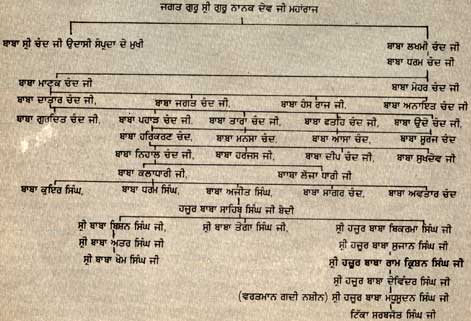
The geneological tree of Guru Nanak

